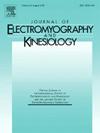Algorithm for jitter measurement in neuromuscular junction disease
IF 2.3
4区 医学
Q3 NEUROSCIENCES
引用次数: 0
Abstract
The objective of this work was to extend the evaluation of a recently proposed method for estimating neuromuscular jitter within motor unit potential (MUP) trains extracted from muscles suffering neuromuscular junction disease. The method detects, within the MUP duration, “single-fiber” intervals that have likely been produced by single muscle fibers. Jitter is then estimated between pairs of these “single-fiber” intervals using an algorithm which incorporates the traditional mean consecutive difference (MCD) parameter.
Electromyographic (EMG) recordings from facial muscles of 15 patients with symptoms related to myasthenia gravis were obtained. MUP trains were extracted using DQEMG software and manual jitter measures were obtained using an ad-hoc graphical interface, which emulates single fiber EMG protocols. Automatic measures for two different values of an internal threshold parameter were obtained and compared to manual measures. 5 %, 25 %, 75 % and 95 % percentiles for the differences between the automatic and manual jitter measurements were [−3.74, −1.47, 1.24, 3.47 μs] and [−6.45, −2.07, 1.65, 7.16 μs], for the two threshold values, respectively. Therefore, very small statistical and clinical differences were found between the automatic and manual jitter measures, supporting the method as an accurate tool for jitter assessment or as a guiding aid for manual procedures.
神经肌肉交界处疾病的抖动测量算法
这项工作的目的是扩展评估最近提出的一种方法,用于估计从患有神经肌肉连接疾病的肌肉中提取的运动单位电位(MUP)训练中的神经肌肉抖动。该方法在MUP持续时间内检测可能由单个肌肉纤维产生的“单纤维”间隔。然后使用结合传统平均连续差(MCD)参数的算法估计这些“单光纤”间隔对之间的抖动。本文对15例有重症肌无力相关症状的患者进行了面部肌电图(EMG)记录。使用DQEMG软件提取MUP列车,并使用模拟单光纤肌电信号协议的自组织图形界面获得手动抖动测量。获得了内部阈值参数的两个不同值的自动测量值,并与手动测量值进行了比较。自动抖动测量值与手动抖动测量值差异的5%、25%、75%和95%的百分位数分别为[- 3.74、- 1.47、1.24、3.47 μs]和[- 6.45、- 2.07、1.65、7.16 μs]。因此,自动和手动抖动测量之间的统计和临床差异非常小,支持该方法作为抖动评估的准确工具或作为手动程序的指导辅助。
本文章由计算机程序翻译,如有差异,请以英文原文为准。
求助全文
约1分钟内获得全文
求助全文
来源期刊
CiteScore
4.70
自引率
8.00%
发文量
70
审稿时长
74 days
期刊介绍:
Journal of Electromyography & Kinesiology is the primary source for outstanding original articles on the study of human movement from muscle contraction via its motor units and sensory system to integrated motion through mechanical and electrical detection techniques.
As the official publication of the International Society of Electrophysiology and Kinesiology, the journal is dedicated to publishing the best work in all areas of electromyography and kinesiology, including: control of movement, muscle fatigue, muscle and nerve properties, joint biomechanics and electrical stimulation. Applications in rehabilitation, sports & exercise, motion analysis, ergonomics, alternative & complimentary medicine, measures of human performance and technical articles on electromyographic signal processing are welcome.

 求助内容:
求助内容: 应助结果提醒方式:
应助结果提醒方式:


